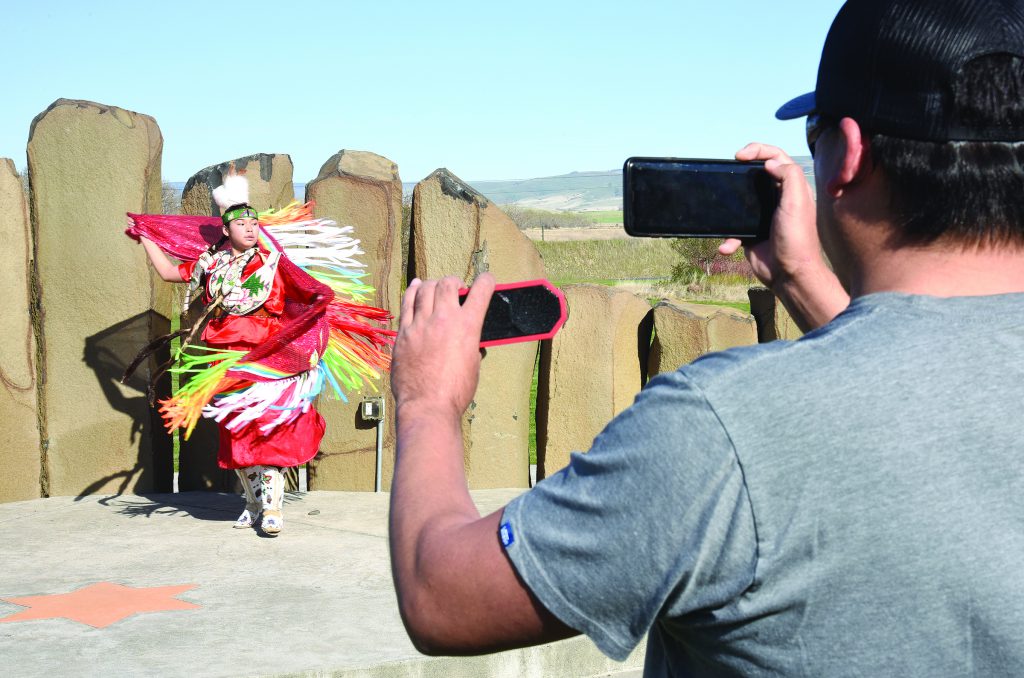By Wil Phinney of the CUJ
WALLULA GAP – Logan Quaempts’ moccasins moved nimbly on the basalt deck, a crisp spring wind off the Columbia River, a setting sun in the west at his back, and it was almost like he was floating in that round bustle, a chicken-dance special to the sound of the Bull Horn Drum from the Blood Reserve in Alberta.
And although Sierra, his wife, videotaping with a cell phone, and a few drivers honking as they motored along Highway 70 near the Twin Sisters were the only other humans around, Quaempts was dancing to the same beat and the same song with hundreds of others competing in a COVID-inspired social-network pow wow.
Quarantine Dance Specials 2020, a Facebook page created on March 24, has more than 55,000 members and averages about 100 dancing posts a day.
Quaempts said he decided to dance late on April 3 and had a spot picked out near Twin Sisters, the basalt lava rock chimneys that carry the legend of Coyote and his siblings, but had to move because of high wind. He ended up closer to the highway, the phone’s camera focused west with the Columbia River behind him squeezed between the rocky cliffs on the south and north shores of the cold, flowing ribbon that separates Oregon and Washington.
He posted his video on Quarantine Dance Specials the next morning where it was judged based on the number of “likes” it received between 8 a.m. and 8 p.m. During that 12 hour period, Quaempts’ chicken dance earned 1,759 likes and finished in third place.
“It’s still being liked and it’s almost up to 3,000 likes with more than 300 shares. I can’t believe it,” said Quaempts, who earned 100 bucks for third place.
The winner and second place finisher had what Quaempts called professionally edited videos.
“We just recorded in two tries. It was too dark to record any more than that,” he said. “So it was pretty neat to have a grainy video that still ended up getting that much love.”
The big question? Was his dance alone along the Columbia River good enough to win on Saturday at the Pendleton Round-Up?
“It felt good, pretty neat to dance by the river,” Quaempts said. “Who knows who the last person was to dance out there? The bells, drums and singing, yeah, I was having fun, not thinking. I was happy to put on my outfit, my roach, to be in the powwow circle.”
Two weeks later Caseymac Wallahee, a powwow MC from White Swan, was contacted by Whitney Rencountre, the co-founder of Social Distance Powwow, another Facebook site promoting Native performers during the COVID-19 crisis. The Facebook group, with more than 165,000 members, allows people to share photos and videos of themselves dancing in regalia.
“He gave me a week’s notice so I put the word out to dancers,” Wallahee said. “I wanted to represent the Plateau round bustle, basket hat and short fringe. He was asking for some powwow dancers and I was noticing everybody was doing powwow intertribal dancing. I told him I want to represent our round bustle and he liked that.”
Wallahee recruited four dancers from the Umatilla Rez – Quaempts, plus Acosia Red Elk, Tyera Pete and Edwina Morning Owl dancing short fringe. Additionally, he gathered other round bustle dancers – Terry Heemsaw Sr. from Toppenish, Gary Villa from Warm Springs and Jeremy Takala from Georgetown; basket dancers – Patricia, Dolly and Jordan Heemsaw from Toppenish; and a fourth short fringe dancer – Destiny Buck from Mattawa (Priest Rapids).
Rencountre initially gave Wallahee one hour for the live show, but after he saw the line-up he told them they can have 90 minutes. Wallahee stretched it another 15 minutes.
All the dancers downloaded an app on their phones then recorded their videos at the same time from remote locations, which they sent to Wallahee, who was in his front yard in White Swan. Quaempts and Red Elk shot their footage from their yards. Pete’s video was taken from in front of the statue at the Pendleton Round-Up grounds.
Terry and Patricia Heemsaw, brother and sister – and neighbors – decided to shoot their dances together.
“I don’t know if they got confused or what?” Wallahee said. “They were up early that morning and set up a tee-pee for their background. Both were on horseback, recorded it and sent it to me, but the video was supposed to be live in half an hour. They were all out of breath from taking the tee-pee down. They thought it was like the Quarantine (Social Dancing Facebook page). I told them ‘This is live.’”
The live feeds were sent to Rencountre who edited and produced the hour-and-45-minute show, which started with Patricia Heemsaw in full regalia on a horse in full trappings.
“That was her idea. She threw it out as a joke, but I told her if she wanted to do it on horseback it would be awesome,” Wallahee said.
Wallahee, who has served as a powwow MC across Indian Country and is the lead singer for the Wild Rose drum, served as the video host, introducing dancers, explaining the history about the round bustle, short fringe and basket hats.
“I just kept it going, threw in a couple jokes, like a powwow MC to keep the crowd in it,” Wallahee said.
The Wallahee video was uploaded to Social Distance Powwow on April 18, but the Umatilla dancers’ notoriety didn’t stop there. A segment was picked up on the local Yakama CBS News affiliate for the network’s regional viewers.
Quaempts grew up on the Umatilla Indian Reservation and started dancing as a “little snot-nosed kid” attending Cay-Uma-Wa Head Start. He remembers his auntie and grandmother making him dress up. He is the grandson of atways Eli and Lucille Quaempts.
He graduated from Weston-McEwen High School in 2009, spent a year in Eugene, then came back to the Reservation.
“As soon as I got back to the circle and heard that drum it took off, like riding a bike,” Quaempts said.
By 2013, Quaempts was competing in round bustle. He won a little money and that was it.
“I started building my outfit. I could feel the transformation. It was under my skin,” he said. “I earned my right as a champion round bustle dancer and it was crazy how my confidence grew. I don’t know where I’d be without it.”
For Quaempts, the son of Steve and Shirley Quaempts and the father of 5-year-old Hazel, dancing is a huge part of his life.
He and Sierra were married last October and “it’s been great,” he said. Quaempts proposed marriage to Sierra inside the arena last year during Round-Up, but it probably wasn’t a surprise; they’d been together for eight years.
“We didn’t know what we expected to change; it stayed the same,” he said, telling Sierra, “I knew you were the one.”
Quaempts used to work for the Tribes’ Housing Department, but he’s become a state-certified caregiver for his grandfather-in-law, Harry James, who moved in with Quaempts’ family three years ago. Harry’s a character and keeps Quaempts on his toes. Harry doesn’t get around as much as he used to, but he still tries to take off now and again, especially now that spring weather has arrived.
Sierra has an “essential” job in the Family Strengths Program at Yellowhawk Tribal Health Center where she works three days a week.
Quaempts said his success wouldn’t be possible without the support of Sierra and his closes friends.
During the COVID-19 “stay-home” period, Sierra has been sewing on Hazel’s outfit. Logan has been making arrowheads because he wants to “knock over an elk with his recurved bow” using hand-made sharps. Hazel has been learning from the school packets the parents fetched from Hawthorne School.
“I’ve also been taking her to the hills, looking for mushrooms, fishing. The other day she gutted a little trout. We’re trying to keep her up on school work and some real life, get her into the weeds and bushes, get dirty, be a kid and go learn.”
Quaempts is hanging on to real-life as well, but the sounds and rhythms that carry him across the tangible dance floor have been transformative in a way that he has trouble describing, yet perhaps his stream of consciousness says it plain enough.
“For me it’s just a feeling, when you walk on and off the floor. I don’t know how to say it. I represent myself and my family. My wife is a big supporter; she really pushes me. And I want to dance for my family because no one else in the family dances. I know who I am and where I come from. I’m glad I represent Umatilla and Mission,” Quaempts said.
When he takes the floor with a good drum group and good song Quaempts loses himself.
“It’s easy to almost … I don’t want to say trance, but it’s almost like floating, almost like, uh, it’s hard to describe. I try to remember the feeling when I walk on, when I’m putting my bells on, getting dressed, even putting my roach away. It’s not a ceremony, how do I say it, putting your outfit away the same way you put it on,” he said.
“Everything is a little ritual, not necessarily spiritual, but pretty good for the soul.”




